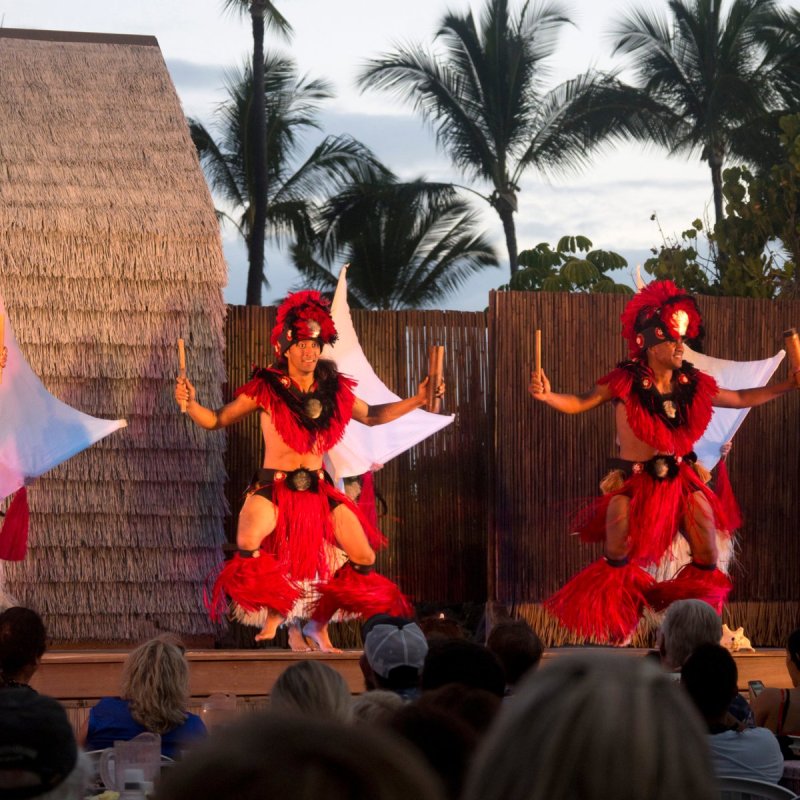
A short description of a luau is that it’s a Hawaiian party full of food and entertainment. But a much better description is that it’s a cultural experience, an act of hospitality, and one of the most memorable things you can do while visiting Hawaii.
Videos by TravelAwaits
In general, a luau includes a buffet dinner (with a mix of traditional Hawaiian cuisine and international flavors), dancing, music, stories, and other cultural performances. During a typical luau, you can usually expect about half an hour of family-friendly activities and different cultural demonstrations, a buffet dinner that lasts about an hour while music plays in the background, and an hour-long performance.
The luau itself dates to 1819 when King Kamehameha II removed the religious requirement that men and women eat their meals separately. Thus, themes of kinship, community, and the importance of family and coming together to enjoy hospitality are very strong.
Fun Fact: The term luau was first used in print back in 1856. The word also refers to the leafy tops of young taro plants, as well as to a popular dish that uses these leaves along with chicken or seafood and coconut cream to create a delicious stew. Yes, you can eat luau at a luau!
Each luau is unique to its own location and set of performers, but some are certainly more touristy than others. The more authentic luaus are focused on culture and sharing Hawaii’s history and stories than on fancy desserts or fashion shows (though those are fun, too!). However, even some of the more culturally sensitive programs will have some less-than-authentic components. They’re hard to avoid entirely. For instance, many people argue that fire dancing isn’t indigenous to Hawaii, though it’s now standard at nearly all luaus.
If you’re not sure where to begin your search, start by asking museum staff. People who work at museums know the local history and culture, and they also know what visitors want. They don’t work for hotels, and so their recommendations are unbiased. If they’re not too busy when you visit, don’t hesitate to ask for their suggestions. This particular list is based on my own personal experiences as well as on HAWAII Magazine’s readers’ choice awards.
Oahu
Alii Luau (Polynesian Cultural Center)
During the day, the Polynesian Cultural Center on Oahu welcomes visitors to explore replicas of different Polynesian villages and to learn more about the culture. You’ll want at least a day to see it all, and two would not be too many. By night, it offers one of the most culturally focused luaus in the state. Visitors appreciate the choice of different buffets (with some more heavily focused on Polynesian flavors like kalua pork and spicy ahi poke, and others more international in nature with fried chicken and spaghetti). This luau also accommodates many budgets. A basic dinner and show package starts at $95 (plus a 15 percent early-bird online booking discount), while VIP packages that include tours of the village go up to $243. Note that alcohol is not offered or permitted at this venue.
Germaine’s Luau
Often described as a backyard-style luau or an oldie-but-goodie option, this long-running luau has a real family spirit to it. Guests are welcomed to Germaine’s Luau with a shell lei and an imu ceremony (in which the food cooked in an imu, or traditional underground oven, is revealed). The down-to-earth menu includes pineapple coleslaw, macaroni salad, sauteed fish, teriyaki beef, and chicken with long rice. Pricing starts at $95 (which includes one alcoholic beverage), and there’s a 10 percent early-bird booking discount, as well as the option for round-trip transportation from Waikiki. Note that some guests report that this luau has a bit more of a party vibe than others on this list.
Paradise Cove Luau
Guests at the Paradise Cove Luau are welcomed with a mai tai and have free time to explore the Hawaiian village with its traditional arts and crafts, test their luck with traditional games, and learn about net fishing techniques. If you’re lucky, you might even be able to participate in the process of pulling the nets from the water! Guests love this luau’s laid-back attitude, beautiful location, and wide variety of activities. A fire show and multiple hula dance performances follow the buffet dinner. The slim menu includes several salads, poi, kalua pork, chicken, fish, and taro buns. Prices start at $107.
Hawaii (The Big Island)
Island Breeze Luau
Located on the grounds of King Kamehameha’s Kona Beach Hotel (which just happens to be the former estate of King Kamehameha the Great) on the Big Island, the Island Breeze Luau takes place next to the Ahuena Heiau, a sacred place of worship. Their family-friendly program includes hula lessons, the chance to get a tattoo (a temporary one, of course), and welcoming the “royal court,” who arrive by outrigger canoe. Other outstanding events include Maori and Fijian dances of war and a Samoan fire knife dance. Guests rave about the creative menu, which includes pickled cucumber-ogo salad, sweet potatoes with coconut butter, Kona coffee barbecue chicken, and fresh papaya. Prices begin at $115, and alcoholic beverages are extra.

Maui
Old Lahaina Luau
One of the most popular luaus in all of Hawaii, the Old Lahaina Luau on Maui strives to offer a culturally sensitive presentation. You won’t see fire dancing here, because it’s not authentically Hawaiian. However, with a long program of other activities, you won’t miss it. The locally focused menu includes dishes you won’t see at other luaus, including poke hee (marinated octopus), pohole salad (fern shoots, local onions, and tomatoes in vinaigrette), luau kalo (taro-and-luau-leaf stew in creamy coconut milk), lau lau (luau-leaf-wrapped pork), and guava cake. Tickets cost $130 and include access to an open bar (which features the local Maui Brewing Co.’s beer). Visitors particularly love the excellent service, friendly staff, and gorgeous sunset location.
Kauai
Smith Family Garden Luau
Welcoming visitors for more than 50 years, this family-run operation on Kauai is big on food. The family recipes used here include teriyaki beef, sweet and sour mahi mahi, chicken adobo, and rice pudding baked in the imu. Guests repeatedly remark that this luau is very well organized, has an authentic family feel, and offers great drinks. The Smith Family Garden Luau’s entertainment program includes Hawaiian hula dances, Tahitian drum dances, and Samoan fire knife dancing. Tickets cost $108, but show-only tickets are just $20.
All Across Hawaii: Mini Cultural Performances
If you want to enjoy genuine Hawaiian music, dance, singing, storytelling, or handicrafts, you don’t have to go to a luau. Some of the best traditional performances are free — and they take place in very untraditional locations! Many shopping complexes and strip malls offer a weekly schedule of free public cultural events that locals and visitors alike are welcome to enjoy. To find a program close to you, visit a tourism office for the inside scoop. Additionally, most hotels will have an up-to-date listing. Alternatively, if you search online for “free activities” and the name of the island you’re visiting, you’ll get a long list of fun freebies, including these shopping-mall offerings.
You also don’t have to attend a luau to enjoy traditional Hawaiian cuisine. In fact, you don’t even need to visit a restaurant. Most supermarkets have small salad bars or even full-service deli counters that offer many of the most popular luau dishes, including poke, macaroni salad, teriyaki chicken, and more. Just how good are they? All the locals lined up to place their orders can’t be wrong!
Pro Tip: Getting Great Value
Nearly all luaus offer a basic package and premium package (and sometimes several other combinations). Premium packages include two important things. First, guests who’ve purchased premium packages get the best possible seating. Second, these guests get to visit the buffet table first. Additionally, premium packages often include extra drinks or other little perks. If you hate sitting in the back or waiting to eat, this is your package!
Show-only tickets sit on the other end of the budget spectrum. As the name implies, these tickets exclude all food and drink and offer entertainment-only admission. These budget-friendly tickets are 50 percent or even 75 percent less expensive than regular tickets. Those with serious dietary restrictions will love this option, as will fastidious eaters, the buffet-averse, and those who paid extra for accommodations with self-catering facilities.
